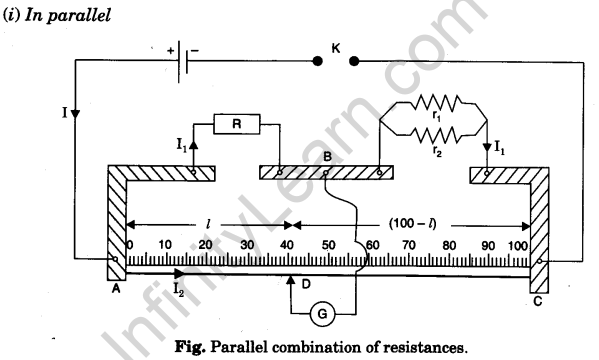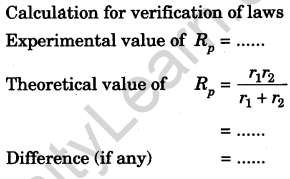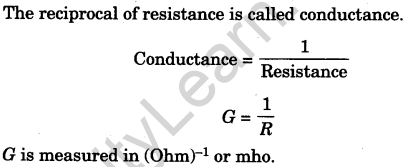Table of Contents
To verify the laws of combination (parallel) of resistances using a metre bridge.
Aim
To verify the laws of combination (parallel) of resistances using a metre bridge.
Apparatus
A metre bridge, a Leclanche cell (battery eliminator), a galvanometer, a resistance box, a jockey, two resistance wires or two resistance coils known resistances, a set square, sand paper and connecting wires.
Theory
![]()
where R is the resistance from the resistance box in the left gap and l is the length of the metre bridge wire from zero end up to balance point.

Circuit diagram


Procedure
- Mark the two resistance coils as r1 and r2.
- To find r1 and r2 proceed same way as in Experiment 1. (If r1 and r2 are not known.)
- Connect the two coils r1 and r2 in parallel as shown in figure in the right gap of metre bridge and find the resistance of this combination. Take at least three sets of observations.
- Record your observations.
Observations
Table for length(l) and Unknown resistance (x)

Calculations

Result
Within limits of experimental error, experimental and theoretical values of Rp are same. Hence, law of resistances in parallel is verified.
Precautions
Same as in Experiment 1.
Viva Voce
Electric current
Question.1.State Ohm’s Law.
Answer.Ohm’s law states that the electric current I flowing through a conductor is directly proportional to the potential difference (voltage) V across its ends (provided that the physical conditions—temperature, pressure and dimensions of the conductor remain same).
Question.2.Give mathematical form of Ohm’s law.
Answer.Mathematical form of Ohm’s law is, V = RI.
Question.3.Define resistance.
Answer.The constant ratio of potential difference V across the ends of a conductor to the current I flowing through it, is called resistance of the conductor. It is represented by the symbol R.
![]()
Question.4.What are Ohmic and non-ohmic resistances?
Answer.Resistances which obey Ohm’s law, are called ohmic resistances e.g., metals like Cu, Al, Ag etc. at low temperature.
Resistances which do not obey Ohm’s law are called non-ohmic resistances e.g., diodes and transistors.
Question.5.Give common examples of non-ohmic resistances.
Answer.Vacuum tube diodes, semi-conductor diodes and transistors are non-ohmic resistances.
Question.6.What is effect of temperature on the resistance of a conductor?
Answer.The resistance of the conductors increases with increase in temperature.
![]()
Question.7.Name some substances whose resistance decreases with increase in temperature.
Answer.Resistance of semi-conductors (Si, Ge) decreases with increase in temperature.
Question.8.How do you conclude that the conductor used in experiment obeyed Ohm’s law?
Answer.It is done by two results :
- The ratio of voltmeter reading (V) and the corresponding ammeter reading (J) comes to be constant.
- A graph between V and I comes to be a straight line.
Question. 9. Why a large current is not allowed to be passed through the conductor during the experiment?
Answer. If a large current is passed (or even if a small current is passed unnecessarily for a long time), the conductor will become hot and its resistance will increase.- Then the graph will not remain a straight line.
Question.10. Why do we use thick connecting wires?
Answer. Thick connecting wires offer negligible resistance compared to given alloy wire whose resistance is to be determined.
Question.11. What is ohm? Define it.
Answer. Ohm is the S.I. unit of resistance. One ohm is the resistance offered by a conductor when one ampere current is flowing through it, when one volt P.D. is maintained across — its ends.
Question.12. What is a battery eliminator?
Answer. It is a rectifier. It converts high A.C. voltage (220 V) into low desired D.C. voltage such as 2 V, 4 V, 6 V, 8 V, 10 V, 12 V. It is a good substitute for a battery or a cell.
Question. 13. Why, unknown wire whose resistance is to be determined, is made of alloys such as manganin, Eureka?
Answer. Unknown resistance wire is made of alloy, but not of metals, because
- The resistivity of alloys is greater than that of metals.
- The temperature coefficient of resistance of alloys is negligible than that of metals.
Question.14. What is the effect of rheostat, range of voltmeter, ammeter on resistance of unknown wire?
Answer. No effect because resistance does not depend upon them.
Question.15. What material is chosen for rheostat wire and why?
Answer. It is constantan alloy. Because its resistivity is high and temperature coefficient of resistance is quite small.
Question.16. What is the material of the connecting wires used in the experiment?
Answer.Copper.
Question.17. Is there any advantage of battery eliminator over usual source of e.m.f.?
Answer. Main advantage of battery eliminator is that current can be drawn at desired voltages and it does not need any charging. It is easy to handle and maintain.
Question. 18. What are the factors affecting the resistance?
Answer. The resistance depends upon length, Area of cross-section, nature of material and temperature of the conductors.
Question.19. What is electric current? Define its S.I. unit.
Answer. The flow of electric charge per unit time through a conductor is called electric current. S.I. unit of current is ampere (A).
The one ampere is the amount of current flowing in a conductor which offers resistance 1 Ohm when one volts potential difference is maintained across the conductor.
Question.20. Define S.I. unit of electric potential.
Answer. Volt is the S.I. unit of electric potential. One volt is said to be the potential difference between two points if one Joule of work is done in bringing one coulomb of charge from one point to the other.
Question.21. Why is a large current not allowed to flow the circuit during the experiment.
Answer. If large current is passed or passed for a long time then wire become hot and its resistance increases. Therefore, the V-I graph will not be a straight line and Ohm’s law is not valid.
Question. 22. Can we take a metal wire in place of alloy wire whose resistance is to be measured?
Answer. No. Because large current will flow and battery will damage.
Question. 23. Why is the ammeter always connected in series to measure the current?
Answer.It is connected in series with circuit in order to measure the current without any change in magnitude.
Question. 24. Why is the voltmeter is connected in parallel?
Answer. So that it can measure the potential drop without any change in its magnitude.
Question.25. Why is the resistance wire on its self before it is wound on bobbin or reel?
Answer. To avoid induction effect.
Resistance
Question.1. Define resistance.
Answer.It is the opposition offered by the material of wire to the flow of electric current, R = V/1
Question.2.How can it measured?
Answer.It can be measured by (i) Ohm’s law (ii) Metre bridge (iii) Multimeter.
Question.3.Define the unit of resistance.
Answer.The S.I. unit of resistance is Ohm (Ω) or volt per ampere. One ohm is the resistance of a conductor carrying current one ampere when unit p.d. is maintained across its ends.

Question.4.What is the cause of resistance?
Answer. Collisions of drifting electrons with the atoms.
Question.5.What is the conductance?
Answer.The reciprocal of resistance is called conductance. It is denoted by G.
G = 1/R S.I. of G is mho, or Siemen.
Question.6.How does resistance depend upon the length of a conductor?
Answer.The resistance is directly proportional to the length of a conductor (provided its area of cross-section remains constant) i.e., R ∝l. It means if length of conductor increases, then resistance increases and vice-versa.
Question.7.How does resistance depend upon the area of cross-section of a conductor?
Answer.The resistance is inversely proportional to the area of cross section of a conductor
(provided its length remains constant) i.e., R ∝=1/A. It means, if area of cross section increases then resistance decreases and vice-versa.
Question.8.What is the resistance of an open key? Explain it.
Answer.

Question.9.What is the length of resistance wire used between the gap of resistance box marked INFINITE? Explain it.
Answer.Infinite marked plug has no wire.
Explanation. We have R = Pl/A We have made R infinite by making A = 0 (rather than by making l infinite).
Question.10.What is the conductance?
Answer.

Question. 11. Define resistivity or specific resistance of the material of conductor
Answer.
![]()
Hence, resistivity is defined as the resistance of a conductor of unit length and unit cross-sectional area. The unit of resistivity is ohm-metre (Ω-m).
Question.12.Define electrical conductivity
Answer.It is reciprocal of resistivity. It is represented by the symbol σ =1/P. The unit of electrical conductivity is Siemen per metre (S m-1).
Question.13.What is the order of magnitude of resistivity of conductors?
Answer. Resistivity of the conductors is of the order of 10-8 Ω-m.
Question.14.What is effect of temperature on the resistance of a conductor?
Answer.Resistance of all conductors increases with increase in temperature of the conductor.
Question.15.Define temperature coefficient of resistance.
Answer.

Hence, temperature coefficient is defined as the increase in resistance of a conductor of unit resistance due to unit increase in temperature.
Question.16.Give unit of temperature coefficient of resistance.
Answer.The unit of temperature coefficient is per °C (or K) (°C-1 or K-1).
Question. 17. How does resistance change in series combination?
Answer. Resistance increases in series combination.
Question. 18. Explain increase of resistance in series combination.
Answer.In series combination, the effective length of resistor increases. As R∝ l, resistance increases in series combination.
Question.19. How does resistance change in parallel combination?
Answer. Resistance decreases in parallel combination.
Question. 20. Explain decrease of resistance in parallel combination.
Answer. In parallel combination, the effective area of cross-section increases. As R∝ 1/A resistance decreases in parallel combination.
Question. 21. What is Wheatstone bridge?
Answer. It is the arrangement of four resistance in quadrilateral form to determine one unknown resistance in term of other three resistances.
Question. 22. What is a metre bridge?
Answer. It is the practical form of Wheatstone bridge to determine the unknown resistance and resistivity of a given alloy wire.
Question. 23. Why is constantan used in the bridge wire?
Answer.
- The resistivity (49 x 10-8 Ω-m) of the constantan is high.
- The temperature coefficient of resistance (a) is very small (0.40 x 10-4 ) (°C-1 ).
Question.24. How are the coils wound in a post office box or resistance box?
Answer. The resistance coil is doubly wound to avoid electromagnetic induction.
Wheatstone’s bridge
Question. 25. When is a Wheatstone’s bridge said to be balanced?
Answer. A Wheatstone’s bridge is said to be balanced, when no current flows through the galva¬nometer and it gives zero deflection.
Question. 26. What is the condition for a Wheatstone’s bridge to become balanced?
Answer.
![]()
Question. 27. Will the interchange of positions of cell and galvanometer effect the balance condition?
Answer. No. The condition of balanced Wheatstone bridge remains satisfied.
Question.28. When is a Wheatstone’s bridge most sensitive?
Answer. The bridge is most sensitive when all the four resistances P, Q, R and S are of same order of magnitude.
Question.29. What are applied forms of a Wheatstone’s bridge?
Answer. The applied forms of a Wheatstone’s bridge are :
- Metre Bridge or Slide Wire Bridge.
- Post Office Box.
Metere bridge
Question. 30. Why is a metre bridge so called?
Answer. Since the bridge uses one metre long wire, it is called a metre bridge.
Question. 31. Why is a metre bridge also called a slide wire bridge?
Answer. Since a jockey is slided over the wire (during the experiment), it is also called a slide- wire bridge.
Question. 32. Why the jockey should not be pressed too hard on the wire when sliding over it?
Answer. Sliding the jockey with a hard press, will scratch the wire and make its thickness non¬uniform. Then the resistance per unit length of the wire will not remain constant because resistance depend upon area of cross-section.
Question. 33. What is null point?
Answer. It is a point on the ware, keeping jockey at which, the galvanometer gives zero deflec¬tion.
Question. 34. Why is it advised to keep null point between 45 cm and 55 cm?
Answer.It is done to minimise the effect of neglecting of end resistances in calculation and Wheatstone bridge is most sensitive when all four arms have same order of resistances.
Question.35. What are end resistances?
Answer. The resistances of thick copper strips which keep the two ends of the wire pressed, are called end resistances.
Question.36. What is an ideal value of null point and why?
Answer. Null point at 50 cm is an ideal null point. It makes, P/Q = 1. This ratio is not affected by neglecting end resistance of equal values at the two ends.
Question.37. How can a null point be obtained near 50 cm?
Answer. It can be done by keeping value of R very near the value of X.
Question.38. Why copper strips, used to pressed the ends of wire, are thick?
Answer. Thick Cu strips have negligible resistance over the resistance of alloy metre bridge wire and minimise effect of end resistances.
Question. 39. Why should the bridge wire have uniform thickness and material density throughout?
Answer. Because only then, the resistance per unit length (σ) will be same throughout. Then P = σ l and Q =σ (100 –l) will be correct.
Question. 40. Why the bridge method for resistance measurement is better than Ohm’s Law?
Answer. It is so because the bridge method is a null method (at null point, there is no current flowing in galvanometer) and more sensitive.
Question. 41. Under what conditions, the metre bridge is most sensitive (and hence result most accurate)?
Answer. The bridge is most sensitive when all the four resistances are of equal value. It brings null point automatically at 50 cm.
Question. 42. Why the metre bridge is suitable for measuring moderate resistances?
Answer. Because, Wheatstone bridge is suitable for moderate values of resistances. Therefore, meter bridge is more sensitive for moderate values.
Question. 43. When the sensitivity of the bridge becomes less?
Answer. Bridge has poor sensitivity when resistances P, Q, R and S (or X) are of different order.
Question. 44. Why should current be passed for a short time?
Answer. Continuous current will cause unnecessary heating and affecting values of resistances used.
Question.45. Why is Wheatstone bridge (or metre bridge) method considered unsuitable for the measurement of very low resistance?
Answer. For measuring low resistance, all resistances and resistance of galvanometer should be f low. The end resistance and connecting wires become comparable to the resistance being
measured and introduce error in the result.
Question. 46. Why is Wheatstone bridge (or metre bridge) method considered unsuitable for
the measurement of very high resistance?
Answer. The resistance forming the bridge should be high and the current in the galvanometer
reduces and it become insensitive.
Question. 47. What are the advantages of a Wheatstone bridge method of measuring
resistance over other methods?
Answer.
- It is a null method, hence the result does not get affected from extra resistances,
- It is easier to detect a small change in deflection than to read a deflection directly.
Question. 48. What do you mean by sensitiveness of a Wheatstone bridge?
Answer. A Wheatstone bridge is said to be sensitive if it produces more deflection in the galva- nometer for a small change of resistance in resistance arm.




